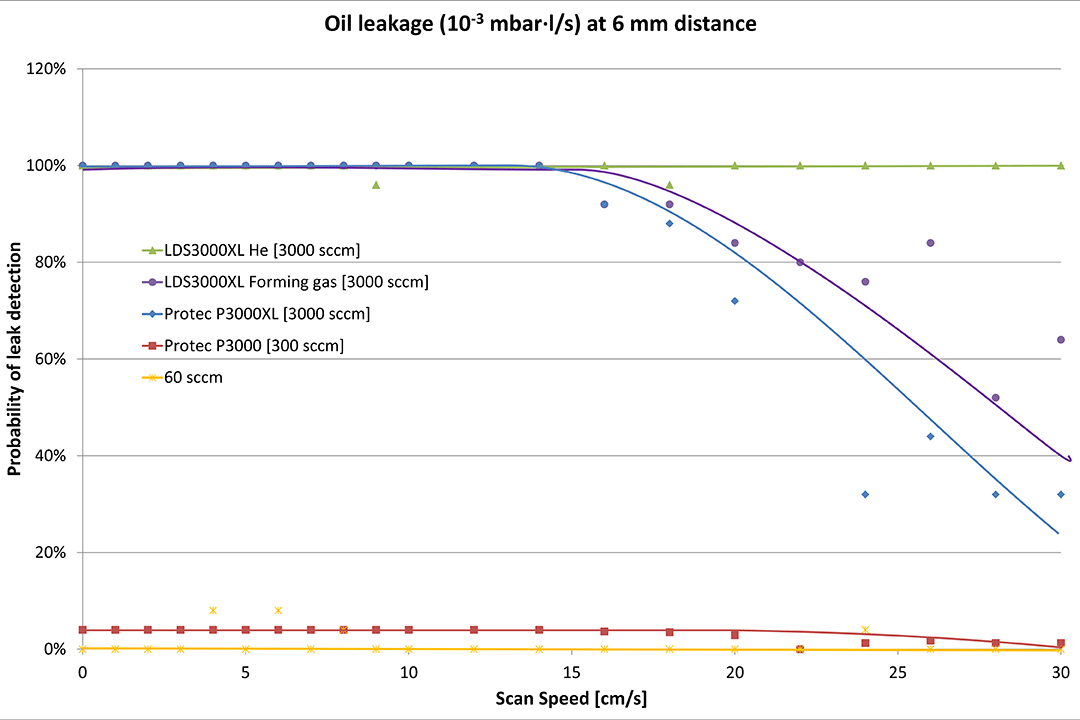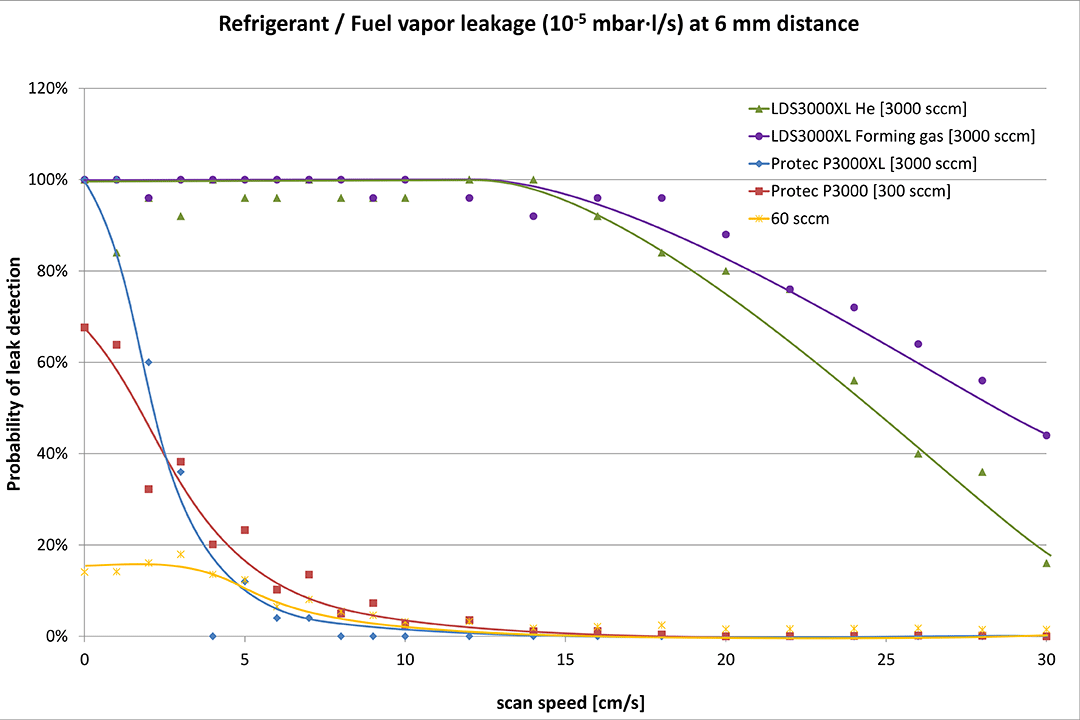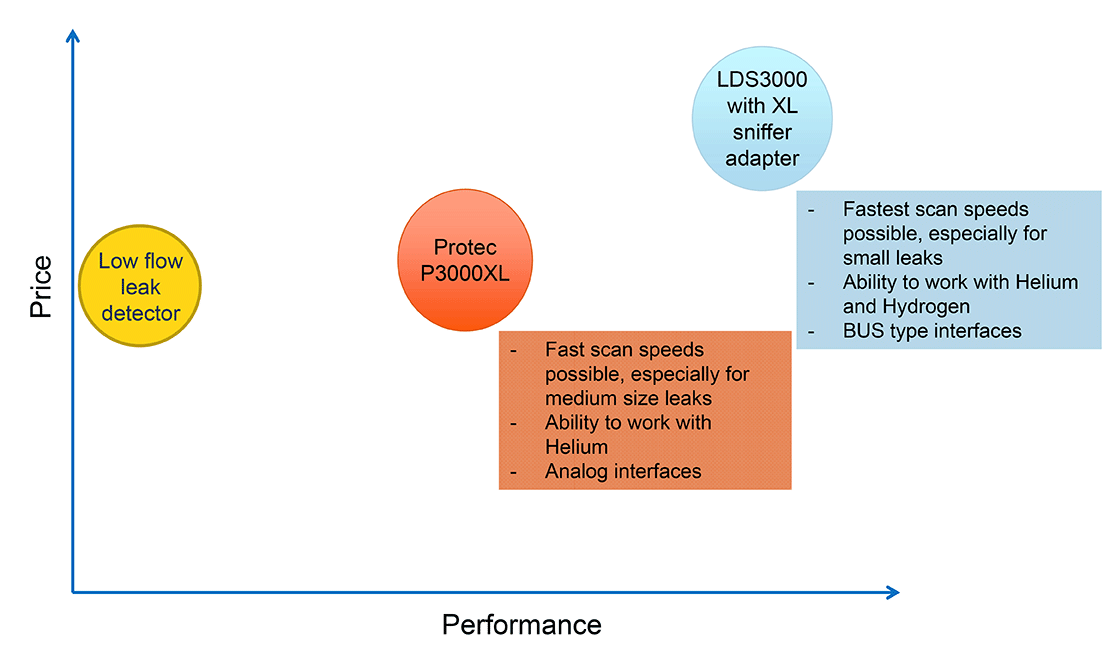How to Choose Between Different High Flow Leak Detectors for Robotic Sniffing
Robotic leak testing is typically used in automated sniffer leak detection setups. In the last release of our AUTO TEST newsletter we explained why the use of high flow is important in robotic leak testing. Today, we will show you the differences between different high flow offerings for tracer gas testing.
Dynamic testing for oil leakage
If a component must be oil-tight, it is typically tested against leak rates in the range of 10-3 mbar∙l/s. For direct comparison, in this example, all testing took place with a test leak of 1 x 10-3 mbar∙l/s and a distance between the sniffer tip and the test piece of 6 mm (~ 0.25 in). This distance was selected as a typical setup for robotic sniffing. (Getting closer to the test piece in a dynamic measurement could result in lack of accessibility or a collision with the product due to varying tolerances in the test piece.)
There is a high probability that all leak detectors with a flow significantly lower than 3000 sccm will fail to detect such leaks. However, there are still more subtle differences between different high flow offerings. The INFICON Protec P3000XL and the LDS3000 with the XL sniffer adapter both use a flow of 3000 sccm. The LDS3000 with XL sniffer adapter used with helium shows the best performance and outperforms the same instrument used with forming gas (5% hydrogen in 95% nitrogen) as well as the Protec P3000XL (for helium). While the latter two may be used up to a scan speed of approx. 15 cm/s safely (detecting 100% of the leaks), the LDS3000 with XL sniffer adapter used with helium did not miss any leaks, even at 30 cm/s.

Even higher requirements for fuel leakage testing
If a component in the automotive industry must be tested for liquid fuel leaks, the leak rates are usually one order of magnitude smaller, i.e. in the 10-4 mbar∙l/s range. In the testing setup, with a distance of 6 mm from the surface of the test piece, but with a 10-4 mbar∙l/s test leak, neither the 60 nor the 300 sccm leak detectors correctly detected a leak of this size, at any test speed. The Protec P3000XL and the LDS3000 with XL sniffer adapter (all with 3000 sccm flow) show the same performance up to approx. 9 cm/s scan speed. While the Protec P3000XL probability to detect the leak steadily declines at higher speeds, the LDS3000 with XL sniffer adapter still detects 100% of all leaks even up to 12 cm/s before starting to decline slowly for both tracer gases (helium and forming gas).

Significantly different performance for even smaller leaks
For leaks even one decade smaller – like when testing for fuel vapor or refrigerant leakage – the difference in performance becomes even more prominent. Testing data was again collected with an approx. 2*10-5 mbar·l/s leak at 6 mm distance. The probability of detecting such small leaks at 6 mm distance with the Protec P3000XL, in spite of its high flow, starts to decline quickly with increasing scan speed. The LDS3000 with XL sniffer adapter, however, can still be used up to 14 cm/s scan speed even for such small leaks very reliably.

Conclusion
The Protec P3000XL is a good standard for robotic testing with helium as tracer gas. It can detect leaks in the 10-3 ... 10-4 mbar·l/s range with high probability even at significant scan speeds at a typical distance from the test piece common in robotic sniffing.
The LDS3000 with XL sniffer adapter is the premium product for this application. It should be used when highest scan speeds are important and / or when detecting leaks in the 10-5 mbar·l/s range like for fuel vapor or refrigerant leakage. In addition, the LDS3000 with XL sniffer adapter can be used with helium or forming gas at nearly the same performance. Last but not least, the LDS3000 with XL sniffer adapter offers modern BUS type interfaces for communication.

Our tip: Please talk to us if you are considering using robotic sniffer leak detection to ensure the quality of your products. We will work with you to determine which leak detector will help you achieve the optimum balance between reliability, speed and cost for your specific application.